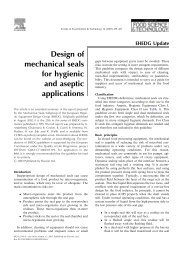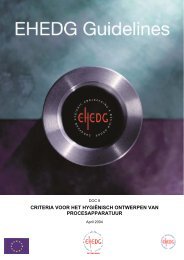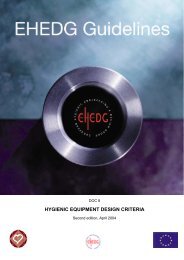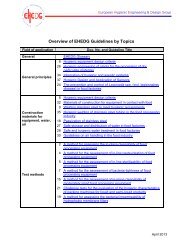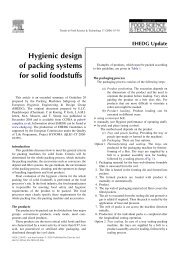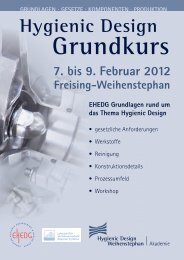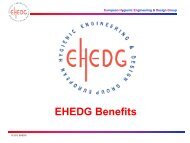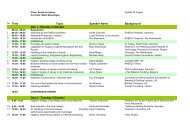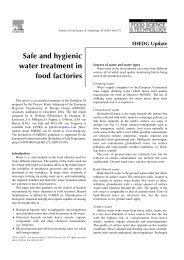Yearbook 2013/2014 - ehedg
Yearbook 2013/2014 - ehedg
Yearbook 2013/2014 - ehedg
Create successful ePaper yourself
Turn your PDF publications into a flip-book with our unique Google optimized e-Paper software.
European Hygienic Engineering & Design Group<br />
Practical considerations for cleaning validation<br />
Hein Timmerman, Diversey, part of Sealed Air, Amsterdam, the Netherlands,<br />
e-mail: hein.timmerman@sealedair.com, www.diversey.com<br />
The European Hygienic Engineering & Design Group<br />
(EHEDG) subgroup Cleaning Validation, chaired by<br />
Professor Rudolf Schmitt of HES-SO in Switzerland, is<br />
working on a new guideline pertaining to cleaning validation<br />
expected to be published in <strong>2014</strong>. Cleaning and/or<br />
disinfection validation is defined as ‘obtaining documented<br />
evidence that cleaning and/or disinfection processes<br />
are consistently effective at reaching a predefined level<br />
of hygiene, if properly implemented on equipment and<br />
production environment and used as intended.’ In contrast,<br />
cleaning verification is defined as ‘the application of<br />
methods, procedures, tests and other evaluations, in<br />
addition to monitoring, to determine whether a control<br />
measure is or has been operating as intended.’ Verification<br />
is sometimes described as the documented evidence<br />
showing that an assigned entity continues to meet the<br />
required (hygiene) specifications. According to International<br />
Standards Organisation (ISO) 22000, verification is the<br />
‘confirmation through the provision of objective evidence<br />
that specified requirements have been fulfilled.’<br />
The goal of developing the new EHEDG guideline is<br />
to provide a complete validation approach suitable for<br />
equipment manufacturers, cleaning product and equipment<br />
manufacturers and all industrial food producers, from smalland<br />
medium-sized enterprises (SME) to multinational<br />
companies. Cleaning validation is a documented process<br />
that shows evidence demonstrating that the cleaning<br />
methods that have been found applicable and acceptable<br />
for a process/product, achieve consistently the required<br />
levels of cleanliness.<br />
The objective of the cleaning validation is to demonstrate<br />
the effectiveness of the cleaning procedures in the<br />
removal of product residues, degraded products,<br />
preservatives, allergens, and/or cleaning, disinfecting,<br />
cross- contamination and enzymatic agents that can post<br />
a risk to the consumer of manufactured food products.<br />
Together, validating cleaning, assuring a validation<br />
standard and achieving consistent results is a topic of high<br />
priority in the food processing industry. Cleaning validation<br />
is used to show proof that the cleaning system consistently<br />
performs as expected and provides scientific data that the<br />
system consistently meets predetermined specifications<br />
for the residuals. However, when starting a new Greenfield<br />
plant, the integration of a validation approach from the<br />
design phase is a good base from which to achieve the<br />
required result. When an existing plant or line requires an<br />
effective and validated cleaning program, a huge amount<br />
of effort will be needed. More than 80 percent of cleaning<br />
procedures and methods executed on a daily basis in the<br />
food industry are not validated and are poorly documented.<br />
Lack of cleaning validation can be one of the root causes<br />
of food safety incidents as it relates to underperforming<br />
cleaning routines.<br />
The validation of process lines is more than the lineup of<br />
single equipment. Implementation of a new validation plan<br />
will require a holistic approach. Validation can absorb a<br />
huge amount of a dedicated team’s time and will have an<br />
economic impact on the manufacturing operation. Finding<br />
the balance between a theoretical and academic-proven<br />
method and the practical realisation of the validation plan<br />
will require good insights in current available technologies<br />
and their practicality on the plant floor. In addition, a simple<br />
engineered line modification, such as the changing of a<br />
pump type or the addition of a valve or new instrument, can<br />
necessitate a new validation of the entire process line.<br />
Validation requires a deep understanding of all elements<br />
involved in the cleaning result, such as the importance<br />
of design and development for an effective program; the<br />
principles and calculations of residue limits for a wide variety<br />
of residue types; routes of administration; and dosage<br />
types the selection of available analytical methods, along<br />
with appropriate levels of analytical method validation.<br />
It also requires a knowledge base about the selection of<br />
sampling methods and sampling sites, along with proper<br />
selection of blanks and controls using the appropriate<br />
strategies and documentation for sampling recovery<br />
studies; the presence of a cleaning validation master plan<br />
and/or policy components; the appropriate documentation<br />
for cleaning validation protocols and reports; the tools used<br />
for monitoring, verification and revalidation; and validation<br />
maintenance for validated cleaning processes.



